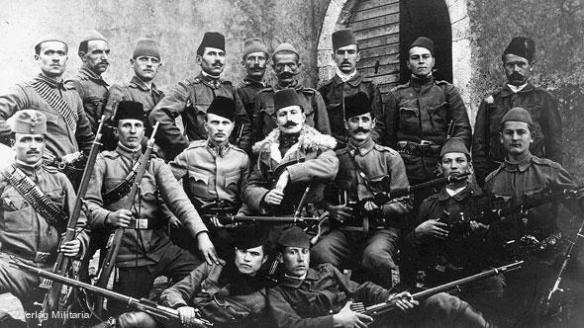The Bosnian-Herzegovinian Infantry (Bosnisch-Hercegovinische Infanterie), commonly called the Bosniaken (German for Bosniaks), was a branch of the Austro-Hungarian Army. As Muslim units, they were granted some special and unique privileges. They had their own uniforms and units were given its own number sequence within the common army.
The units were part of the Austro-Hungarian infantry in 1914 and consisted of four infantry regiments (numbered 1-4) and a Field Rifles Battalion (Feldjägerbataillon).
Bosnian infantry regiments differed from all other units of the Austro-Hungarian army in their uniforms. The most distinctive characteristic garment of this European military force was the Oriental fez, which was worn on parade and for field uniform. The Fez was made of reddish-brown felt and equipped with a tassel of black sheep’s wool. This tassel was 18.5 cm long and mounted on a rosette fringes. The fez had to be worn such that the tassel was at the back. Officers and cadets often wore alternate Austrian military infantry caps. If the officers were Muslims, they could also wear the fez. If the officer was not Bosnian then he wore a standard Austro-Hungarian officer’s beret instead. Tunics and blouses were consistent with those of the standard German line infantry. The buttons were yellow with the respective regimental number. Officers’ uniforms consisted of blue coats with red collar and yellow buttons, and from 1894 the uniform featured the regiments’ numbers.
Ordinary soldiers had a light blue uniform with trouser pants bearing so-called knee breeches after the oriental models. They consisted of the two leg parts and the leg pieces (like the German V-away or breeches of the armed forces – but instead issued after the front side) that were each composed of a front and back. At the front were two diagonally cut pockets. The leg parts were kept far below the knee and narrowed from there. The running down Wade pieces were connected by a 3.5 cm wide alliance of double pleated fabric with the leg parts.
The Field Rifles Battalion (Feldjägerbataillon) had a different uniform. The officers and cadets wore the same uniform as the Tyrolean Jägerbataillon, while the ordinary soldiers wore grey uniforms with a grey fez. The žandamerijskom Corps is particularly striking as the men wore the hat with black feathers.
Note:In Austro-Hungarian sources of that time soldiers from Bosnia were called as just Bosniaken(eng. Bosniaks, bos. Bošnjaci) of Muslim, Orthodox and Catholic faith.
In terms of modern nationality, those Orthodox population of Bosnia are part of Serbs nation, Catholics of Croats nation, while Muslim population of Bosnia = Bosniaks.
Books written about it:
– Werner Schachinger, “Die Bosniaken kommen! Elitetruppe in der k.u.k. Armee 1879 – 1918”
– Hans Fritz, “Bosniak”
– Ahmed Pašić, “Bošnjaki na Soški fronti”
– Werner Schachinger, “I Bosniaci sul fronte Italiano”
– Pero Blašković, “Sa Bošnjacima u svjetskom ratu”
– Pero Blašković, “BH3”
– Group of authors, “Des Kaisers Bosniaken”
It seems that troops from Bosnia and Herzegovina were best part of k.u.k. army in WW1.
Especially Second Regiment with 42 highest, golden medals for bravery, record holder in entire army.
In total, troops from Bosnia and Herzegovina earned 106 golden medals, 63 of them were for Muslim soldiers. According to Werner Schachinger, even non Bosnia units would sometime use Bosnian fez to make enemy think they are fighting against Bosniaks, what was discouraging. It seems that most famous venture of them was battle for Monte Meletta during last days of May and first days of June in the year 1916, where Bosnian troops destroyed Italian forces.
